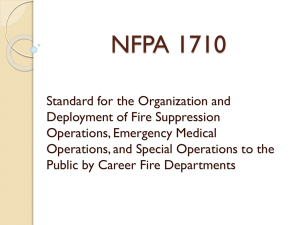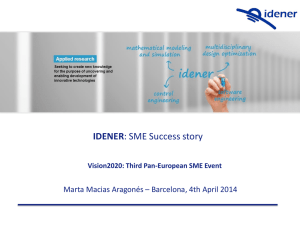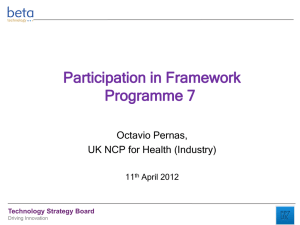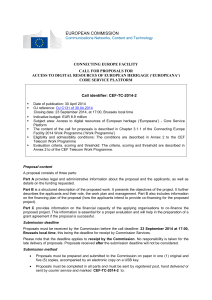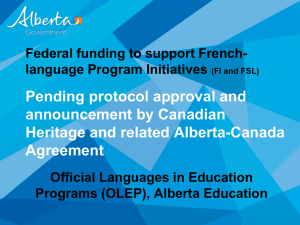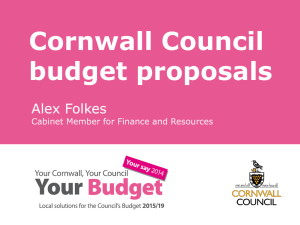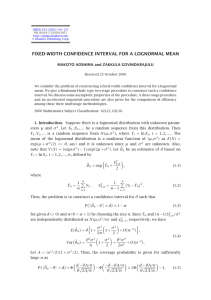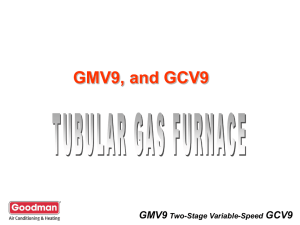Stage 1
advertisement
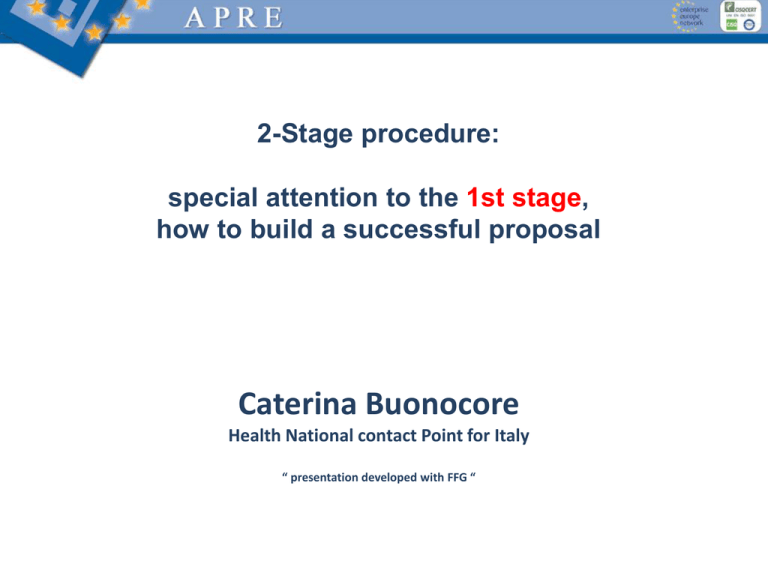
2-Stage procedure: special attention to the 1st stage, how to build a successful proposal Caterina Buonocore Health National contact Point for Italy “ presentation developed with FFG “ FP7 Health Participation FP7 Health Participation Why two-stage procedure? • History: two-stage calls introduced in 3rd Call FP7-Health2009, since then increasing numbers of two-stage topics, since 6th Call ONLY two-stage call • New “strategy“ of EC towards the end of FP7 • less topics open per call • several projects funded per topic • broader topics • decrease „writing burden“ for applicants in 1st stage • increase success rates for full stage proposals How to write two-stage proposals (I) Example Guide for Applicants 6th Call 6th Call FP7-HEALTH-2012 – two subcalls 1. FP7-Health-Innovation-1 2. FP7-Health-Innovation-2 “SMEs for Innovation“: special subcall, shorter procedures, only for European partners, max. 5 partners Stage 1- Administrative issues : • Only the coordinator completes the A-forms (A1, A2 and A3) • In form A3, only a single set of budget figures and the corresponding requested EU funding is required for the whole project. • Do not complete additional A2 and A3 forms for the other partners How to write two-stage proposals (II) Example Guide for Applicants 6th Call Cover Page stage 1 • Proposal full title: • Proposal acronym: • Type of funding scheme: • Work programme topics addressed: • Name of the coordinating person: • List of participants: How to write two-stage proposals (III) Example Guide for Applicants 6th Call List of participants: List all the expected members of your consortium. Participant no. Participant legal name Country Organisation type* Describe briefly the role(s) in the consortium, name of the scientific person in charge, expertise, capacity and resources to achieve the objectives 1 (Coordinator) 2 3 .. .. How to write two-stage proposals (IV) Example Guide for Applicants 6th Call Please indicate the estimated budget for the proposed work as accurately as possible. Estimated budget Participant no. RTD Demonstration Management Other activities activities 1 2 3 .. .. Total eligible costs Requested EU contribution Requested EU contribution for SMEs in % of the total requested, if applicable Requested EU contribution for industry in % of the total requested, if applicable Total costs EU contribution How to write two-stage proposals (V) Example Guide for Applicants 6th Call Stage 1 proposal content (maximum 6 pages for section 1 and 2 together) 1: Scientific and/or technical quality, relevant to the topics addressed by the call 1.1 Concept and objectives Explain the concept of your project. What are the main ideas that led you to propose this work? Describe in detail the S&T objectives. Show how they relate to the topics addressed by the call, which you should explicitly identify. The objectives should be those achievable within the project, not through subsequent development. They should be stated in a measurable and verifiable form, including through the milestones that will be indicated under section 1.3 below. How to write two-stage proposals (VI) Example Guide for Applicants 6th Call Stage 1 proposal content (maximum 6 pages for section 1 and 2 together) 1.2 Progress beyond the state-of-the-art Describe the state-of-the-art in the area concerned, and the advance that the proposed project would bring about. If applicable, refer to the results of any patent search you might have carried out. 1.3 S/T methodology and associated work plan Present an overview. How to write two-stage proposals (VII) Example Guide for Applicants 6th Call Stage 1 proposal content (maximum 6 pages for section 1 and 2 together) 2. Impact 2.1 Expected impacts Provide an overview on how your project will contribute towards the expected impacts listed in the work programme in relation to the topic or topics in question. Mention the steps that will be needed to bring about these impacts. Mention any assumptions and external factors that may determine whether the impacts will be achieved. When appropriate (relevant for the topic): With regard to the innovation dimension, describe the potential areas and markets of application of the project results and the potential advantages of the resulting technologies/ solutions compared to those that are available today. How to write two-stage proposals (VIII) Example Guide for Applicants 6th Call • The maximum combined length for sections 1and 2 is six pages. • Note: The cover page, the participant list, the budget table and the table of contents (see below) do not count toward the page limits specified for stage 1. • The minimum font size allowed is 11 points. The page size is A4, and all margins (top, bottom, left, right) should be at least 15 mm (not including any footers or headers). • Ensure that the font type chosen leads to clearly readable text (eg. Arial or Times New Roman). • As an indication, such a layout should lead to a maximum of between 5000 and 6000 possible characters per page (including spaces). • The Commission/agency will instruct the experts to disregard any excess pages. How to really do it! • use Arial Narrow as font type! • none or minimal literature references in 1st stage 1.1: Concept and objectives - around 1 - 1.5 pages • describe overall idea and concept, list objectives with e.g. bullet points (first overall objective(s), then detailed specific objectives) • try to answer the following questions in the 1st paragraphs…. • • • • • Why bother? What problem are you trying to solve? Is it a European priority or could it be solved at national level? Is the solution already available? Why now? What would happen if we did not do this now? Why you? Are you the best people to do this work? How to really do it! 1.2. Progress beyond the state-of-the-art => around 0.5 to 1 page • Clearly oppose STATE OF THE ART vs PROGRESS BEYOND/ INNOVATION 1.3. S/T methodology and associated work plan => 2 - 3 pages • this is the core part of the application! and should include short workpackage descriptions, and milestones, a small diagramm to illustrate WP connections (Pert Chart), etc. How to really do it! 2.1. Expected impacts => around 1 page What impact will your results generate, how and by whom will the results be used? – Which results are expected? • Applications? Commercial, social or scientific? – Who is the Lead User of these results? – How relevant are the results for the Lead User? – How do the results get to the lead user? • Dissemination and Exploitation? Which partners are involved? – How will the exploitation/dissemination be done? • Intellectual Property Rights (IPR) – Production, Marketing, Licenses, Patents, etc. How to really do it – Summary and Tips • has to be excellent, innovative idea that fits 100% to the call topic • readers has to be “captured” by idea after the first paragraph • the 1st stage is a “mini full proposal” – not just a vague idea, but a fully structured proposal with specific objectives, workpackages, milestones etc. • clear impact section – if SMEs involved, describe impact for each SME and for the market • can be divided into scientific impact – clinical impact – economic impact – societal impact…. • even if not asked for, try to include your consortium skills in some sentences throughout the proposal – you are the best! • projects with clinical trials: some essential trial data need to be described in 1st stage already (patient numbers, in- and exclusion criteria…) Stage 2- Full Stage SUMMARY OF MANDATORY PAGE LIMITS (conforming to font and margin sizes mentioned above). – – Section Maximum pages – 1: Scientific and/or technical quality, – – 1.1 Concept and objectives – 20 pages for whole section*, No specific limit – – – – 1.2 Progress beyond the state-of-the-art – No specific limit S/T methodology and associated work plan – 1 page for section 1.3 (i) ("Overall strategy") – 2 pages for each work package description in section 1.3 (d)] 1.3 – 2.1 Management structure and procedures – 5 pages – – – – – – – – 2.2 Individual participants – 1 page per participant 2.3 Consortium as a whole – No specific limit 2.4 Resources to be committed – 2 pages 3. Impact – 10 pages for whole section – – – – 4. Ethics Issues – No limit – 1 page 5. Consideration of gender aspects – * This limit does not include the Gantt chart under 1.3 ii), the tables 1.3a- e, and the Pert diagram under 1.3 iv). Evaluation (I) • Innovation-1: Stage 1 proposals will be evaluated remotely by independent external experts, then discussed in consensus meetings Table 4: Thresholds for evaluation criteria for first stage Criterion Minimum threshold S/T quality 4/5 Impact 3/5 Overall threshold 8/10 • all proposals passing all thresholds will be retained at stage 1 Put yourself in the shoes of an evaluator! 1. Let’s divide into 5 groups ( 7/8 each); 2. Read the proposal individually; (15 min) 3. Note down how you evaluate it for S&T and Impact. (5 min) 4. Start the discussion with your team and draft together your evaluation on a ppt if possible (15 min) 5. Present your evaluation to the other groups ( 4 min) Does it go through to second stage?
